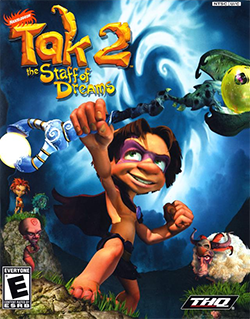Plot
Following the events of the first game, Tak is trapped in the Dream World as Jibolba and Lok ponder how to awaken him. The Dream Juju tells Tak that he must fight the Dream Guardian and retrieve the Staff of Dreams to escape the Dream World.
During his quest, Tak periodically escapes the Dream World via rifts, enabling Jibolba to accompany him. The two rescue Jibolba's brother JB, who helps Tak enter the tower where the Dream Guardian resides.
Tak obtains the Staff of Dreams, but the Dream Juju reveals himself to be his old enemy Tlaloc and the princess to be his henchmen, Pins and Needles. Tlaloc obtains half of the staff, the Staff of Nightmares, while Tak gets the other, the Dream Shaker. This power causes all to enter the real world, and Pins, Needles, and Tlaloc escape. Tak chases them, but is knocked out.
The Moon Juju visits Tak and empowers him to battle the villains. Tlaloc is killed in battle, but he returns as a nightmare creature and transforms into a monster resembling the Dream Guardian. After Tak defeats Tlaloc, the Dream Guardian returns him to the real world. Afterwards, Jibolba and Lok wake Tak up, telling him that the previous events were a dream. The three walk off while being spied on by a sheep from Tlaloc's army.
This page is based on this
Wikipedia article Text is available under the
CC BY-SA 4.0 license; additional terms may apply.
Images, videos and audio are available under their respective licenses.
